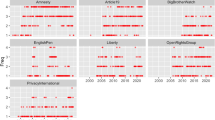Abstract
This chapter explores the possibilities of the digital archive, using as a case study the project to digitise the vast Kaldor Public Art Projects (KPAP) archive. This case study entails consideration of the intentions of the KPAP organisation in commissioning a digital archive: to make the extraordinary store of archived materials easily available to the public; and to create a living archive, in which historical materials may be made available for referencing and creative re-use by contemporary artists, writers and researchers. Decisions on editing, redaction, censorship, privacy and copyright of archive materials were made during the construction of the digital archive: these decisions and deliberations are discussed.
Access this chapter
Tax calculation will be finalised at checkout
Purchases are for personal use only
Similar content being viewed by others
Notes
- 1.
Anthony Bond, ‘An Australian Odyssey: Connecting to International Contemporary Art’, p. 25.
- 2.
Robert Ellis Smith, Ben Franklin’s Website (2004), p. 8.
- 3.
Jordan Robertson, ‘NSA Spying Shows Perils of Apps’, Sydney Morning Herald, 31 January 2014, p. 16. I consider the implications for privacy in the internet age, in more detail, in The New Time and Space, pp. 113–129.
- 4.
Julia Fioretti, ‘Google Starts to Block Search Results after Privacy Ruling’, Sydney Morning Herald, 28–29 June 2014, p. 44.
- 5.
New York Times editorial cited by Jeffrey Toobin, ‘The Solace of Oblivion’, The New Yorker, 29 September 2014, p. 28.
- 6.
Karen Kissane, ‘At Last, a Reporter’s Insight into Life under the “criminal-in-chief”’, Sydney Morning Herald, 1 December 2011, p. 13.
- 7.
McNealy and Schmidt quoted by Sherry Turkle, Alone Together, p. 256.
- 8.
Andrew Stevenson, ‘Cyberspace: It’s the New Toilet Wall’, Sydney Morning Herald, 21–22 July 2007, p. 30.
- 9.
‘Privacy No Longer a Social Norm, Says Facebook Founder’, The Guardian, 11 January 2010, at http://www.theguardian.com/technology/2010/jan/11/facebook-privacy.
- 10.
Zuckerberg quoted by Jeff Jarvis, ‘Privacy, Publicness and the Web: A Manifesto’ at http://ieeexplore.ieee.org/stamp/stamp.jsp?arnumber=5779789. Accessed 27 March 2019.
- 11.
Davies quoted in Murad Ahmed, ‘Zuckerberg’s Revamp Plans Causing Friction’, The Australian, 16 November 2011, p. 12.
- 12.
Emily Nussbaum, ‘Kids, the Internet and the End of Privacy’, The Weekend Australian Magazine, 24–25 March 2007, p. 24.
- 13.
Sherry Turkle, Alone Together, p. 254.
- 14.
Lawrence Lessig, Code and Other Laws of Cyberspace, p. 125.
- 15.
Mark Rose, Authors and Owners, p. 3.
- 16.
DJ Spooky quoted in Andrew Murphie and John Potts, Culture and Technology, p. 70.
- 17.
Daniela Simone, Copyright and Collective Authorship, p. 77.
- 18.
Simone, Copyright and Collective Authorship, p. 73.
- 19.
Simone, Copyright and Collective Authorship, p. 91.
- 20.
Simone, Copyright and Collective Authorship, p. 73.
- 21.
Michel Foucault, ‘What Is an Author?’, p. 124.
- 22.
Mark Rose, Authors and Owners, p. 64.
References
Bond, Anthony, ‘An Australian Odyssey: Connecting to International Contemporary Art’ in Forbat, Sophie (ed), 40 Years: Kaldor Public Art Projects, Sydney: Kaldor Public Art Projects, 2009.
Coates, Rebecca, The Rise of the Private Art Foundation: John Kaldor Art Projects 1969–2012, PhD Thesis, Melbourne: University of Melbourne, 2013.
Coates, Rebecca, ‘John Kaldor’s Early Art Projects and the NGV’ in Art Journal No. 54, Melbourne: National Gallery of Victoria, 2015.
Ellis Smith, Robert, Ben Webster’s Website: Privacy and Curiosity from Plymouth Rock to the Internet, Providence: Privacy Journal, 2004.
Foucault, Michel, ‘What Is an Author?’ in Language, Counter-Memory, Practice: Selected Essays and Interviews, ed. Donald F. Bouchard, trans. Donald F. Bouchard and Sherry Simon, Ithaca: Cornell University Press, 1980 [1969].
Lessig, Lawrence, Code and Other Laws of Cyberspace, New York: Basic Books, 1999.
Lessig, Lawrence, Free Culture: How Big Media Uses Technology and the Law to Lock Down Culture and Control Creativity, New York: Penguin, 2004.
McLeod, Kembrew, Freedom of Expression: Overzealous Copyright Bozos and Other Enemies of Creativity, New York: Doubleday, 2005.
Murphie, Andrew and Potts, John, Culture and Technology, Basingstoke: Palgrave Macmillan, 2003.
Potts, John, The New Time and Space, Basingstoke: Palgrave Macmillan, 2015.
Rose, Mark, Authors and Owners, Cambridge: Harvard University Press, 1993.
Simone, Daniela, Copyright and Collective Authorship, Cambridge: Cambridge University Press, 2019.
Turkle, Sherry, Alone Together: Why We Expect More from Technology and Less from Each Other, New York: Basic Books, 2011.
Author information
Authors and Affiliations
Corresponding author
Editor information
Editors and Affiliations
Rights and permissions
Copyright information
© 2021 The Author(s), under exclusive license to Springer Nature Switzerland AG
About this chapter
Cite this chapter
Potts, J. (2021). Making the Temporary Permanent: The Digital Archive. In: Potts, J. (eds) Use and Reuse of the Digital Archive. Palgrave Macmillan, Cham. https://doi.org/10.1007/978-3-030-79523-8_2
Download citation
DOI: https://doi.org/10.1007/978-3-030-79523-8_2
Published:
Publisher Name: Palgrave Macmillan, Cham
Print ISBN: 978-3-030-79522-1
Online ISBN: 978-3-030-79523-8
eBook Packages: Literature, Cultural and Media StudiesLiterature, Cultural and Media Studies (R0)




